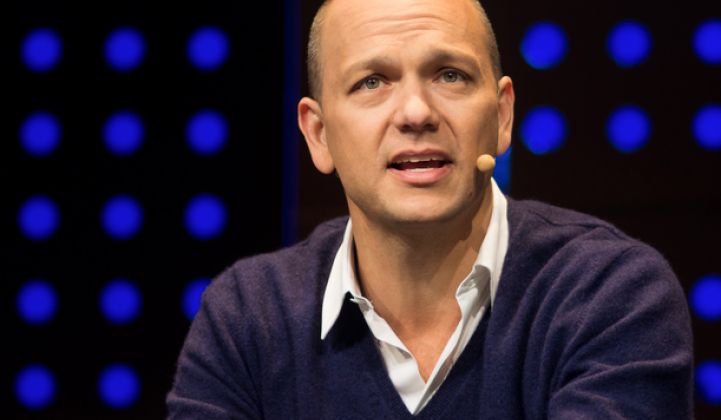Late last week, Nest co-founder, design guru and alleged tyrant CEO Tony Fadell announced his departure, amidst a very long-running public airing of his conflicts with former employees, including the founder of webcam acquisition Dropcam.
Besides the personal and personnel problems, Fadell has reportedly been chafing under financial restrictions from Nest’s newly reorganized parent company, Alphabet (aka Google), which apparently wants its $3.2 billion acquisition to start making more money, or stop spending as much.
What does this all mean for Nest’s future in energy efficiency and distributed energy?
That will depend, first, on whether Nest’s new management can create a connected home business strategy that can break open a still-tiny market; and second, whether new CEO Marwan Fawaz decides that energy deserves more attention than Nest has generally given it to date.
Let’s take the first question of growing market share. Nest’s smart thermostats make saving energy, and thus money, a key selling point, and can shave 10 percent to 20 percent off a home’s heating and cooling costs. That’s about average for most of today’s smart thermostats, which match energy usage patterns and customer comfort and preferences to achieve more consistent savings than old-fashioned programmable thermostats.
And as Alphabet CEO Larry Page noted in this week’s earnings call, millions of Nest thermostats are being used today, with sales growing at 50 percent year-over-year. To be sure, that's not a lot of thermostats in the grand scheme of things -- just 1.3 million in 2015, and 2.5 million in total over the past few years, according to research firm Strategy Analytics.
Still, Nest’s smart thermostat initially stood out for breaking low expectations for the industry. But Fadell always made it clear that his focus was less on energy savings, and more on the broader “connected home,” with a vision of a growing array of sleekly designed, networked gadgets under the Nest brand. On that front, it hasn’t lived up to expectations. Its smoke detector was a bit of a flop, and its Nestcam was a thinly redesigned Dropcam. Since then, it’s failed to deliver anything new, although it’s tightened up problems with integration between its existing devices, and has promised new products this year.
According to reports, Nest’s new CEO, former Motorola executive Marwan Fawaz, is being brought in to tighten the company’s focus and impose financial discipline. That indicates that it's not likely the firm will be developing lots of new products. Indeed, Nest’s shakeup fits into a recurring pattern in the home automation world -- overreach and retrenchment. For the most part, homeowners continue to pass on the nifty smart appliances and connected-home hubs on display at CES each year.
Instead, Nest has refocused as a “hardware + software + services ecosystem,” as Fadell said in his parting statement. Today, that’s mainly through its Works With Nest program, with scores of brand-name partners like ADT, Lutron, Philips, Control4, Vivint Home, Comcast, AT&T Digital Life and Amazon's Echo.
Of course, very few people are buying enough home automation devices to need an “ecosystem” today. Only about 6 percent of U.S. homes have a smart device, according to Forrester. Part of the problem is that the industry has been hampered by expensive and proprietary technologies, which makes achieving greater openness in the future a key goal.
Nest hasn’t always been the best partner on this front. We’ve heard reports from industry insiders saying the company has been loath to open its thermostats or data to partners in utility projects they’ve done together. Nest has also acquired technology just to take it off the market, as it did with the Revolv hub.
Nest’s installed base could certainly make it an attractive partner for device providers of all descriptions, although relatively few so far are focused on energy. Most of its Works With Nest partners are making door locks, motion detectors, key fob locators, and other such non-energy-related items, and it also has its fair share of software partners.
Nest is working with a handful of companies’ smart devices with energy implications, including smart LED lighting from Philips Hue, smart plugs from Zuli, electric-vehicle chargers from ChargePoint, water heaters from Heatworks and Rheem, and appliances from Whirlpool and LG. But right now, most of these integrations entail relatively simple data presentment and control, more aimed at customer convenience than as part of an integrated energy strategy.
There’s certainly a role for Nest to play in a distributed-energy-equipped home. SolarCity picked Nest thermostats, along with Tesla batteries and Steffes smart water heaters, as part of its package for Hawaii customers under the state’s new self-supply solar tariff. Nest is also working with microinverter maker Enphase’s home energy management platform, and has tied in with Alarm.com’s EnergyHub for demand response programs.
Whether or not these integrations help Nest retain its role as the connected home standard-bearer remains to be seen. Behind the scenes, many of the companies on the Works With Nest partner list are also competitors, with their own thermostats and their own plans of becoming the integration partner of choice for the consumer market. There's no doubt that Google remains focused on the connected home, although its approach has been a bit scattered.
At the same time, Nest's consumer appeal has made Nest a favored partner with utilities and retail energy providers, which have heavily subsidized deployments around the country. Some are mainly pushing simple energy efficiency, but others are using Nest’s Rush Hour Rewards demand response platform, which has shown it’s capable of steep peak energy reductions from customers as well. As Nest seeks to tighten the financial hatches, it may well seek out more utilities and energy services companies to drive sales -- even as it continues to hype the connected home at large.



